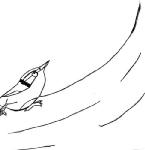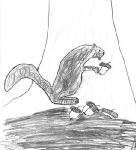|
Mrs.
Stroud's class of St. Paul, MN responds to the pre-experiment
questions:
-What
animals do you think live on or around Antarctica?
Class:
We think the following live in Antarctica: seals,
penguins, polar bears, white foxes, puffins, walrus,
wolves, fish, deer.
Gwynne responds: Although all of these animals
live in cold climates, few of them actually live
within the Antarctic circle. You were right on
for your guesses of seals, penguins, and fish.
A lot of the other animals you guessed live by
the North pole. You will never see a polar bear
indigenous to the South Pole or a penguin to the
North Pole.
-Do
you think there are any animals common to both your
area and Antarctica?
Class:
We think dogs are common to both areas.
Gwynne
responds: At one point, sled dogs were taken on
expeditions across the continent. Nowadays, because
of the Antarctic Conservation Treaty, dogs are
no longer allowed here. In fact, all non-native
Antarctic animals (excluding humans) are banned
from here. This is an effort to keep Antarctica
pristine and in it's natural condition.
-Which
place do you think has more life? Why?
Class:
We think that would be Minnesota because it is
warmer here.
Gwynne
responds: This is a tricky question. If you compare
the life on land here with Minnesota, then Minnesota
definitely wins. There is very little that lives
on land on the Ice. However, if you take into
account the marine life here, then Antarctica
has more life. Almost all life must survive along
the coast so in those areas, the amount of life
per space (or density of life) is very, very high.
Much more so than Minnesota.
-How
would you expect the animals in your environment
to be different from ones in an Antarctic environment?
Class:
We think that warm weather animals couldn't live
in Antarctica. They wouldn't need a lot of thick
fur in Minnesota, only in winter.
Gwynne
responds: Thick fur is a definite plus here. I
consider my parka to be the equivalent of what
several of the animals naturally have. Just to
give you an idea of how well animals are adapted
to the environment down here, I will mention some
of peculiarities of the penguin. It has a large
volume to surface area ratio (reduces the amount
of heat lost through skin), it has thick feathers
that make it windproof, it has a layer of blubber
(more insulation), it has small appendages which
are mostly covered by feathers (hard to keep the
extremities heated), and it has nasal passages
that keep heat from being lost through breathing
out.
-What
do you think the differences would be caused by?
Class:
The differences would be caused by temperature
and weather.
Gwynne responds: I think you are totally right.
I might add that the environment (desert, mountains,
plains, and coast here) causes differences to
develop.
Mrs.
Stroud's class of St. Paul, MN responds to the post-experiment
questions:
-
Why do you think the animals are different?
Class:
We
think they are different because the animals in
both places must have weather that is different
so they can live all year.
-
What things are there in common between the animals
of your area and of the Antarctic?
Class:
There
are birds and mammals in both areas. If the bird
or animal is going to survive, their body must
change or they will die.
-
Why do the animals have anything in common?
Class:
Birds
and mammals are alike everywhere. The differences
come in when the climate changes.
Gwynne
adds:† Very true.† Birds and mammals are alike
everywhere because they evolved from the same
critters.† It helps to compare it to how human
families work.† Think about your brothers and
sisters.† You may or may not resemble your siblings,
but there are usually some similarities.† This
makes sense because you and your siblings share
parents.† Now imagine your brothers and sisters
and you way in the future with children of your
own.† The children of your siblings would be cousins
of your children.† All these cousins may look
similar, but generally speaking, brothers and
sisters resemble each other more often than cousins
do.† Evolution works in a very similar way, but
on a much larger scale and over a much longer
time.
-
How do the differences between the animals help
them survive in their natural habitat?
Class:
If the bears didnít have thick fur, they couldnít
live in Antarctica. The birds need special kinds
of feathers and seals need more fat so they could
stand the weather.† If those animals came to Minnesota
in the summer, they would die because it would
be too hot.† We do have some animals here in our
zoos that are the same kind of animals that live
in Antarctica.
Gwynne
adds:† You have the right idea, but there arenít
actually any bears in Antarctica.† Polar bears
live by the North Pole.Ē
These
pictures are by some of the kids in Mrs. Stroudís
class

Lee's Bird |

Peter's Insect |

Halston's Spider |
|
|

Anthony's Squirrel |
|
|